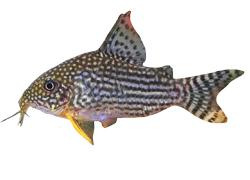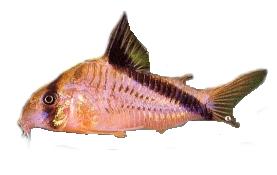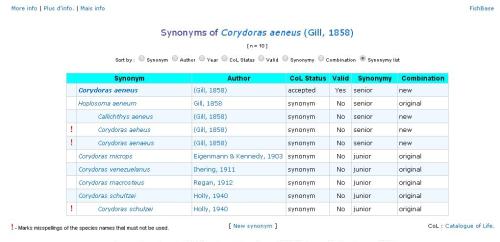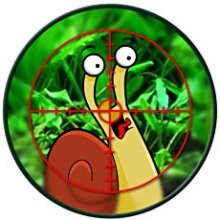Corydoras pygmaeus – The Pygmy Corydoras or Pygmy Catfish, Corydoras pygmaeus, is a tropical and freshwater fish belonging to the Corydoradinae sub-family of the Callichthyidae family. It originates in inland waters in South America, and is found in theMadeira River basin in Brazil. The fish will grow in length up to 0.75 inches (2.1 centimeters) with females being larger than the males. It lives in a tropical climate in water with a 6.0 – 8.0 pH, a water hardness of 2 – 25 dGH, and a temperature range of 72 – 79°F (22 – 26°C). It feeds on worms, benthic crustaceans, insects, and plant matter.
Breeding – It lays eggs in dense vegetation and adults do not guard the eggs. The female holds 2-4 eggs between her pelvic fins, where the male fertilizes them for about 30 seconds. Only then does the female swim to a suitable spot, where she attaches the very sticky eggs. The pair repeats this process until about 100 eggs have been fertilized and attached.
In the Aquarium – Pygmy corydoras are of commercial importance in the aquarium trade industry.
It is a peaceful fish and can be kept in a community aquarium of smaller fish species such as ember tetras. It can be fed most sinking foods but may eat flakes. It enjoys frozen food and sinking wafers. It can be kept with small shrimp and snails. These cories should’t be kept in tanks smaller than 10 gallons because they like room to swim around. Used fine grained substrate or their little barbels may wear down. Keep the temperature between 70 and 80 degrees Fahrenheit with a pH of 6.0 – 7.5.
They are peaceful fish and like to live in groups of at least four and will also behave much more naturally in larger groups (10 or more). Unlike the larger more common Corydoras, they often swim in a shoal around mid water regions as well as the lower regions of the tank.
C. pygmaeus are good pets as they are fairly hardy. However, there are several things to keep in mind when planning to keep this species. They are inoffensive fish which will not thrive with aggressive tankmates. They are perhaps best kept in a planted species tank, or with shrimp such as Neocaridina spp. They seem to do best when offered live foods in addition to prepared food items. Appropriate foods include microworms or similar nematodes, as well as Artemia nauplii (newly hatched brine shrimp.)
Acquisition: Acquired (15) of them some fish didn’t fare so well and died the next day.
Corydoras sterbai – Sterba’s corydoras (Corydoras sterbai) is a member of the South American Corydoras genus of freshwateraquarium catfish and one of the most popular species of Corydoras due to its attractive markings.
Sterba’s Cory is distinguishable from other Corydoras species as it has white spots on its head from eyes down to snout. It is occasionally confused with Corydoras haraldschultzi; the difference is that the latter has a pattern of black dots on a white background on the head, C. sterbai has a pattern of white dots on a black background.C. sterbai has recently become available in an albino form and a black form.
Like many Corydoras species, Sterba’s cory is a shoaling catfish, and thus should ideally be kept in groups of 5 or more. In the wild it can be found in Brazil and thus, wild caught fish prefer soft, acidic water. However, Sterba’s cory is a hardy fish and tank bred specimens have adapted to a wider range of water conditions. However, like almost all fish it will not tolerate high levels of nitrates.
Unlike some other catfish they are not good algae eaters, but are good at “cleaning up” leftover food and detritus from the substrate.
Coryodras sterbai are relatively small for catfish, growing to a maximum size of only 2–2.6 inches (5.1–6.6 cm).
In the aquarium: In captivity Corydoras sterbai readily accepts a wide variety of prepared and frozen foods. Flake food is a good staple diet (which will only be consumed once it has fallen to the bottom) as are sinking pellets/wafers. They relish live and frozen foods such as bloodworm, daphnia andmosquito larvae, but ideally should only be fed such foods once a week due to the high amount of protein in them.
It is often problematic to feed Corydoras in aquaria with fast feeding mid-water fish such as tetras as flake and sinking pelletsare consumed by such fish before they have hit the bottom and sometimes, even while lying on the substrate. However, this problem can be overcome by placing pellets and flake on the aquarium substrate in caves or under bogwood, or other such areas which are not regularly frequented by mid-water fish.
Ideally Corydoras sterbai should be housed with a fine substrate such as sand or gravel in order to avoid doing damage to their delicate barbels. However, large gravel will suffice as long as it is not sharp edged. Their only other requirement is that shade be provided for them, by means of overhanging rock, large leaved plants, arching bogwood and/or caves.
Breeding is not too difficult; good diet together with repeated water changes and drops of temperature are usually sufficient. However, raising the fry is not easy due to its high sensitivity.
Name: The species name of this Corydoras is in honor of Professor Dr Günther Sterba, professor emeritus of zoology of Leipzig University, member of the Royal Swedish Academy of Sciences. Professor Sterba is a professional ichthyologist who nevertheless produced several very popular books regarded as virtual bibles for fishkeepers over the 1970s and 1980s, translated into English under the titles Freshwater Fishes of the World, Aquarium Care and (with Dick Mills) The Aquarists’ Encyclopedia, despite his degree of isolation at that time by virtue of living in the then German Democratic Republic.
Acquisition: Bought these (6)on AQUABID, to replace the tank full that I lost due to unknown causes. The breeder raises and sells a lot of these fish, so I figured its a prolific strain!
Corydoras cf. schultzie black – fish called Black Cory or Black Schultzei, over here (Black Venezuela in Holland) and a tank bred variaty (not found in the wild)?The black form appears in a localized area in the Central Llanos of Venezuela, close to the Middle Orinoco. These tributaries are typically slow and very warm. The black form is only found in the Llanos in drainages of the Orinoco. This mix up only happens in the US partially due to the fact that the black C. venzuelanus were bred there by Don Kinyon and partially due to the lack of the pictured fish in the US until later than Europe. They were developed in Germany but since then have been extensively bred in the Czech Republic, there is a post by Ian Fuller on this thread explaining it.
viewtopic.php?f=6&t=32934&p=219184&hilit=The+true+all+black+cory#p219184
C. schultzei as well as C. venezuelanus are scientifically no valid species as the holotypes are lost and they are officially considered to be synonyms of C. aeneus. If this is justified or not is more or less impossible to tell (without holotypes).
The original description of the species does not allow to tell which species/from of the aeneus group were given these names.
In Venezuela there is more than one species of the aeneus group and as far as I know there is no proof that the nice corys with orange heads that we know from Venezuela and we associate with the name C. venezuelanus are really the ones Ihering used in his work. At least there is a useful type locality given. Does anyone has/knows of pictures of living corys from the type locality or does anyone has confirmed catching locations of “our C. venezuelanus” ?
With C. schultzei it is even more uncertain: the type locality is pretty much unknown. The holotype was an aquarium fish said to original from “small water-courses of the Amazon”. The aquarium specimen that we hobbyist call C. schultzei originate from Colombia as far as I know and I don’t know of any proof that these are the same species as described.
Acquisition: Bought these (6) on AQUABID. They are beautiful fish.The breeder raises and sells a lot of these fish, so I figured its a prolific strain!
Corydoras mellini – Bandit or False Bandit Cory – The bandit corydoras is a tropical freshwater fish belonging to the Corydoradinae sub-family of the Callichthyidae family. It originates in inland waters in South America, and is found in the upper Rio Negro and Meta River basins in Brazil and Colombia.
The fish will grow in length up to 2.0 inches (5.0 centimeters). It lives in a tropical climate in water with a 6.0 – 8.0 pH, a water hardness of 2 – 25 dGH, and a temperature range of 72 – 79 °F (22 – 26 °C). It feeds on worms, benthic crustaceans, insects, and plant matter. It lays eggs in dense vegetation and adults do not guard the eggs. The female holds 2-4 eggs between her pelvic fins, where the male fertilizes them for about 30 seconds. Only then does the female swim to a suitable spot, where she attaches the very sticky eggs. The pair repeats this process until about 100 eggs have been fertilized and attached.
The bandit corydoras is of commercial importance in the aquarium trade industry.
Acquisition: Additional (4) from Marine Warehouse in Tampa FL.
Corydoras paleatus – Peppered_Cory – Corydoras paleatus is a species of catfish (order Siluriformes) of the family Callichthyidae. Its common names include blue leopard corydoras, mottled corydoras and peppered catfish. It originates from the lower Paraná Riverbasin and coastal rivers in Uruguay and Brazil.
Corydoras paleatus is a species of catfish (order Siluriformes) of the family Callichthyidae. Its common names include blue leopard corydoras, mottled corydoras and peppered catfish. It originates from the lower Paraná River basin and coastal rivers in Uruguay and Brazil.
Description – This fish species reaches about 5.9 centimeters (2.3 in) SL. The male is smaller than the female and in proportion to body length, the dorsal fin and pectoral fins are longer on the male than the female.
Ecology – Corydoras paleatus is found in the amazon basin, and feeds on worms, crustaceans, insects, and plant matter. Corydoras paleatus has been known to produce sound; it does this by abduction of its pectoral fins. This is used by males during courtship and intrapersonal communication, and by both sexes and juveniles when distressed.
In reproduction, males do not behave aggressively toward each other, nor do they monopolize mating areas or females.The T-position is involved in courtship, as with many other Corydoras species.
In the aquarium – Corydoras paleatus is a very good choice for the community aquarium, as it is a hardy, good looking, and peaceful fish. They can be successfully kept with other small, peaceful aquarium fish like livebearers, danios and tetras. It is sometimes seen in the shops as an albino form, although this is similar to other albino corys (see the C. aeneus albino form). It grows to around 7.5 cm, and is easily bred at home.
These fish have sensitive barbels and one should have the proper substrate for them. To keep their barbels (whiskers) in the best condition one requires the fine gravel that looks like coarse salt. This is available in white and brown, both look good. Beware that fry are difficult to spot on the brown gravel. Gravel with sharp edges will cut their barbels (until they are gone). Their barbels are important for finding food, and should remain healthy.
These fish prefer a planted tank with temperatures around 60 to 75 ° Fahrenheit (20 – 24 ° Celsius) although they can take lower temperatures than this. Their high temperature tolerance seems poor and 30 °C (85 °F) is the highest safe temperature. They like to nibble on the algae that grows on floating plants, but are not a specialized algae-eating catfish. The lighting must not be too bright and hiding places, such as bogwood (also known as mopani wood) are needed as they like to hide from the light during certain parts of the day. Heavily planted areas should also be provided, where the light is minimized, as they like darker areas due to their bottom-feeding nature.
Diet – Diet should be sinking pellets, algae wafers, frozen and live food, such as bloodworm or daphnia. They may also occasionally enjoy blanched spinach, which can be attached to plants with a peg or the side of the glass with magnetic clips. They can be seen to dart to the top of the tank: this is because they can use atmospheric oxygen to supplement what their gills extract from the water. They will do this more frequently when water quality is starting to deteriorate, and so should be watched for this indication.
Spawning – The males initiate the courtship ritual, which entails chasing the females around the tank. The female darts away and the males search for her and find her a few moments later. The males shiver all over the female and may lie down on top of her. When she is ready to spawn she turns to the male next to her and pounds furiously below his ventral fin. The male releases his seed and the female catches it in her mouth. The female cups her ventral fins and lays a few eggs (normally about 4) in them. She now starts cleaning a spot on the glass to lays her eggs on. Corydoras are egg depositors and lay their eggs all over the aquarium. Favorite spots include the heater, filter tubes and the glass, although, occasionally eggs are also laid on plants. After depositing a group of eggs closely together, the female rests for a few moments. The males regroup and start chasing each other and then resume chasing the female. The males are so relentless in this pursuit that they try to mate with the female even while she is busy laying her eggs. The spawning lasts more than an hour and many eggs are laid.
Raising the fry – The eggs should hatch in about six days. Peppered catfish will eat their fry. At first the fry will eat mainly the protozoan organisms in the tank, but will soon be able to eat fry foods.
Acquisition: Additional (6) from Marine Warehouse in Tampa FL.
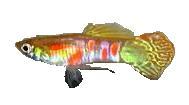 Ginga Sulpherus Guppies – Poecilia wingei – Ginga Sulpherus Guppies is a strain of guppies developed recently These are a relatively recent hybrid strain developed by Alan S Bias by crossing K. Tanaka’s Ginga Rubra and his Vienna Emerald LS guppies. This Guppy breeds true and is a very beautiful guppy. Alan’s website details the development of the Ginga Sulphureus Strain, here is the URL: http://swordtailguppies.blogspot.com/2012/08/ginga-sulphureus-evolution-of-new.html
Ginga Sulpherus Guppies – Poecilia wingei – Ginga Sulpherus Guppies is a strain of guppies developed recently These are a relatively recent hybrid strain developed by Alan S Bias by crossing K. Tanaka’s Ginga Rubra and his Vienna Emerald LS guppies. This Guppy breeds true and is a very beautiful guppy. Alan’s website details the development of the Ginga Sulphureus Strain, here is the URL: http://swordtailguppies.blogspot.com/2012/08/ginga-sulphureus-evolution-of-new.html
http://swordtailguppies.blogspot.com/search?q=GINGA+SULPHUREUS
References:
Most information acquired is from Wikipedia copyright!
Planet Ctafish reference posts: http://www.planetcatfish.com/forum/viewtopic.php?f=6&t=40714#p277766


